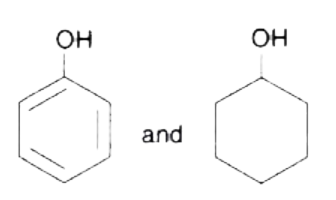Give a chemical test and the reagents used to distinguish between the following :
'Ethylamine and diethylamine'
To distinguish between ethylamine (C2H5NH2) and diethylamine (C2H5)2NH, we can use the Hinsberg test. Here’s a step-by-step solution:
Step 1: Understand the Compounds
- Ethylamine is a primary amine (1° amine) with the structure C2H5NH2.
- Diethylamine is a secondary amine (2° amine) with the structure (C2H5)2NH.
Step 2: Prepare the Hinsberg Reagent
- The Hinsberg reagent is benzene sulfonyl chloride (C6H5SO2Cl). This reagent is used to react with amines.
Step 3: Perform the Reaction with Ethylamine
- React ethylamine with benzene sulfonyl chloride.
- The reaction will produce N-ethylbenzene sulfonamide (PhSO2NHC2H5).
- This product is soluble in potassium hydroxide (KOH) because it has an acidic hydrogen.
Step 4: Perform the Reaction with Diethylamine
- React diethylamine with benzene sulfonyl chloride.
- The reaction will produce N,N-diethylbenzene sulfonamide (PhSO2N(C2H5)2).
- This product is insoluble in potassium hydroxide (KOH) because it does not have an acidic hydrogen.
Step 5: Analyze the Results
- After performing the reactions, check the solubility of the products in KOH:
- N-ethylbenzene sulfonamide (from ethylamine) is soluble in KOH.
- N,N-diethylbenzene sulfonamide (from diethylamine) is insoluble in KOH.
Conclusion
- By using the Hinsberg test, we can distinguish between ethylamine and diethylamine based on the solubility of the resulting sulfonamide products in KOH.
---
- Ethylamine is a primary amine (1° amine) with the structure C2H5NH2.
- Diethylamine is a secondary amine (2° amine) with the structure (C2H5)2NH.
- The Hinsberg reagent is benzene sulfonyl chloride (C6H5SO2Cl). This reagent is used to react with amines.
- React ethylamine with benzene sulfonyl chloride.
- The reaction will produce N-ethylbenzene sulfonamide (PhSO2NHC2H5).
- This product is soluble in potassium hydroxide (KOH) because it has an acidic hydrogen.
- React diethylamine with benzene sulfonyl chloride.
- The reaction will produce N,N-diethylbenzene sulfonamide (PhSO2N(C2H5)2).
- This product is insoluble in potassium hydroxide (KOH) because it does not have an acidic hydrogen.
- After performing the reactions, check the solubility of the products in KOH:
- N-ethylbenzene sulfonamide (from ethylamine) is soluble in KOH.
- N,N-diethylbenzene sulfonamide (from diethylamine) is insoluble in KOH.
- By using the Hinsberg test, we can distinguish between ethylamine and diethylamine based on the solubility of the resulting sulfonamide products in KOH.
Topper's Solved these Questions
- ORGANIC COMPOUNDS WITH FUNCTIONAL GROUPBOOK - CENGAGE CHEMISTRY ENGLISHCHAPTER - ORGANIC COMPOUNDS WITH FUNCTIONAL GROUPEXERCISE - Archives Fill In The Blanks
3 Videos
- NUCLEAR CHEMISTRYBOOK - CENGAGE CHEMISTRY ENGLISHCHAPTER - NUCLEAR CHEMISTRYEXERCISE - Archives Subjective
13 Videos
- P-BLOCK GROUP 15 ELEMENTS - THE NITROGEN FAMILYBOOK - CENGAGE CHEMISTRY ENGLISHCHAPTER - P-BLOCK GROUP 15 ELEMENTS - THE NITROGEN FAMILYEXERCISE - Exercises Archives (Subjective)
28 Videos
Similar Questions
Give a chemical test and the reagents used to distinguish between cyclohexane and cyclohexene.
View SolutionGive one good chemical test to distinguish between the following pair of compounds: Methylamine and dimethylamine.
View SolutionGive the chemical tests to distinguish between the following pairs of compounds :
(i) Ethylamine and Aniline
(ii) Aniline and Benzlamine
View SolutionGive chemical test to distinguish between

View SolutionGive a chemical test to distinguish between each of the following pairs :
Ethane & ethanol
View SolutionGive a chemical test to distinguish between the following gases
HCI and CI2
View SolutionGive a chemical test to distinguish between each of the following pairs :
Methane & ethyne
View SolutionGive a chemical test to distinguish between the following gases
NH3 and HCI
View SolutionGive a chemical test to distinguish between the following pairs of compounds:

View SolutionGive a chemical test to distinguish between the following gases
H2 and CO2
View Solution
